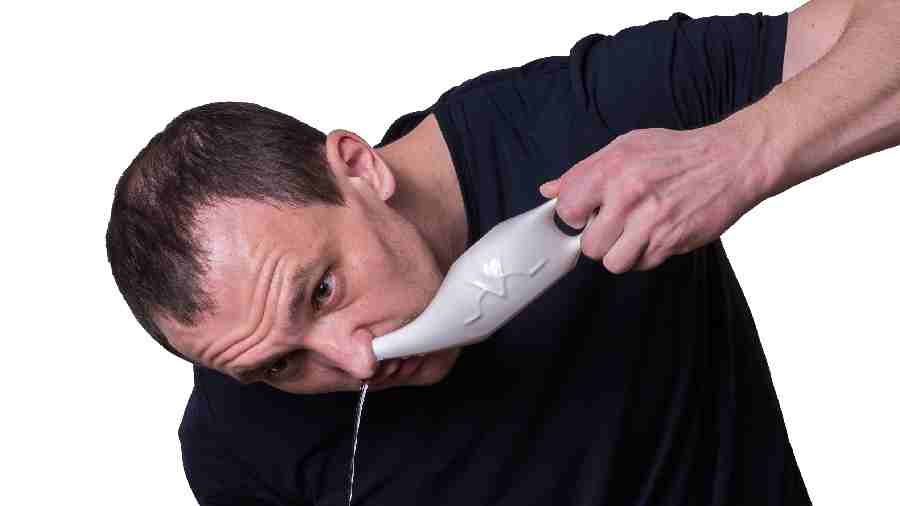To the uninitiated, the neti pot may seem like yet another wellness trend. After all, the teapot-like vessel was popularised in the US by celebrity surgeon Dr Mehmet Oz, who called it a “nose bidet” on The Oprah Winfrey Show and has been criticised for promoting unproven supplements and health products.
Rinsing warm salt water through your nose — in one nostril and out the other — as an antidote for a variety of woes like sinus inflammation, congestion and allergies may seem strange and possibly scary. But according to ear, nose and throat doctors, nasal rinsing, which traces back thousands of years to the Ayurvedic medical traditions of India, is an unusual example of a practice that is at once ancient, trendy and evidence-based. And, it’s safe and inexpensive to boot.
It has a “very, very high level of evidence, randomised controlled trial evidence, that shows that it does work and it does help,” said Dr Zara Patel, an associate professor of otolaryngology at the Stanford University School of Medicine in the US. Here’s what we know.
When you inhale, the mucus in your nose traps all sorts of undesirable particles from the air, like viruses, bacteria, allergens and pollutants, said Dr Rakesh Chandra, a professor of otolaryngology at Vanderbilt University Medical Center in Nashville, US. Microscopic hairs in the nose then sweep those trapped particles, with the mucus, into the throat so they can be swallowed into (and largely neutralised by) the gut.
This filtering system generally works well, but sometimes, people “react to that stuff that’s getting caught up in the mucus,” leading to inflammation that can cause symptoms like congestion, pressure and pain, Chandra said.
This is where nasal irrigations can be so helpful. “One of their biggest functions is to sort of wash all that stuff out so that it doesn’t collect in the sinus cavities and elicit those reactions,” he said.
Nasal rinsing is also thought to thin the mucus and reduce swelling that can cause congestion. “It’s like a sort of natural decongestant,” Patel said.
In 2021, an international team of experts published a consensus on how best to manage common sinus issues, like chronic inflammation of the nasal and sinus passages that can cause runny nose, congestion, impaired sense of smell and facial pressure or pain. They concluded, based on the best yet limited evidence, that regular rinsing with saltwater was one of the treatments most proven to be effective.
Other small studies have suggested that saltwater rinses can help with seasonal or environmental allergy symptoms like congestion, runny nose, itching and sneezing.
Although the evidence that rinsing helps with these various nasal issues is of mixed quality, experts say there are few downsides to trying it. “The risk is so low and the potential benefit so high for rinsers” that it’s worth giving it a go, said Dr Nyssa Farrell, an assistant professor of otolaryngology at Washington University School of Medicine in St. Louis, US.
For people with chronic sinus inflammation, Patel recommends rinsing twice per day — morning and evening. For those with milder symptoms, daily rinsing may be enough.
How do you rinse properly? First, choose your rinsing apparatus. Patel prefers a simpler plastic squeeze bottle because it’s easy to use and offers slightly more pressure than a neti pot.
Next, prepare your saltwater solution correctly. The US Centers for Disease Control and Prevention recommends purchasing distilled or sterile water, or using tap water that has been boiled for at least one minute and then cooled.
Then, add the salt. It’s easiest to use premixed salt packets sold over the counter as a dried powder mix, but you can easily make your own salt solution using pickling or canning salt (don’t use table salt, which has too many additives).
To rinse your nose, stand over the sink or in the shower, bend forward, and tilt your head to one side. While breathing through your mouth, gently squirt or pour about 4 ounces of your solution into the upper nostril, letting it run out the lower nostril. Some may run into your mouth. Repeat on the other side.
If you’ve heard reports of nasal rinsing causing fatal amoeba infections of the brain, it may be hard to wash that fear from your mind. “That risk is real,” Farrell said, but it’s “exceedingly low”. To her knowledge, three cases have been reported in medical literature in the United States in the past decade or so. All were associated with rinsing with untreated or improperly treated water.
Tap water may contain low levels of amoebas and still be safe to drink, because stomach acid can kill these organisms. However, it’s not safe to put untreated tap water in your nose.
Can nasal rinsing help treat Covid-19? The coronavirus primarily infects people through the nose, so early in the pandemic, researchers and doctors wondered if nasal rinsing could help treat Covid-19 infections.
In one study of recently diagnosed Covid-19 patients published this month, researchers found that when compared with participants who didn’t do any nasal rinses, those who rinsed with saline solution twice a day for 21 days had no improvement in their symptoms and had the same amount of coronavirus in their noses.
Dr Justin Turner, one of the study’s authors and an associate professor of otolaryngology at Vanderbilt University Medical Center, said he was surprised by these results, but another experiment in the study offered an explanation. “The virus is just produced so rapidly that no matter how much of it you wash away, the virus is continuously produced,” he said.
NYTNS











